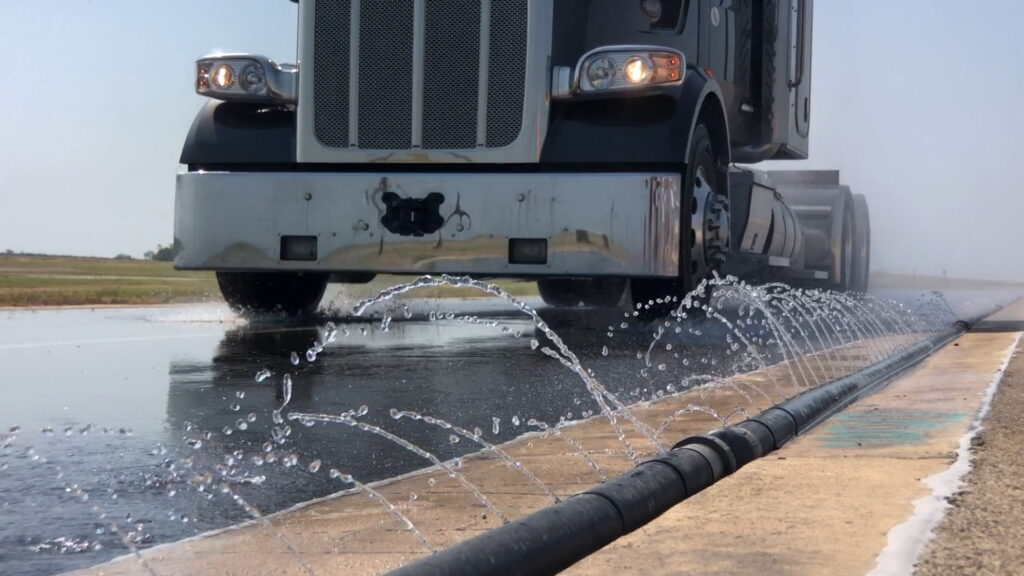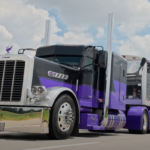Tires have become one of the most significant expenses for fleets, ranking third or fourth in terms of cost. However, they are often treated as mere commodities, disregarding their true value. Tires are much more than simple round and black objects. They undergo extensive engineering and testing processes, particularly those belonging to the top-tier category. Sadly, many tire consumers fail to consider these aspects and base their selection solely on price, which is not necessarily the best criterion.
In an effort to shed light on the intricate world of tire engineering, Continental Tire recently organized an event called ContiExperience. They invited a group of truck journalists to visit their proving ground complex located in Uvalde, Texas. The event aimed to provide reporters, dealers, and select fleet customers with hands-on demonstrations of various tire testing and evaluation experiences, as well as a comprehensive tour of the proving grounds.
The Uvalde Proving Grounds (UPG), which serves as the home for Continental Tire Research & Development North America, covers a vast area of almost 5,000 acres. It is situated approximately 12 km (8 miles) south of Uvalde, Texas, and around 135 km (85 miles) west of San Antonio. This facility has the capability to test and evaluate tires of all types, ranging from passenger car and light truck tires to medium- and heavy-duty trucks, and even enormous earth-mover tires.
The UPG benefits from a hot and dry climate, enabling year-round testing under consistent conditions. On any given day, the site may have up to 20 or 30 testing programs in progress. Continental rents access to the site to various original equipment manufacturers (OEMs), research companies, and other interested parties. Every year, testers and researchers cover approximately 3.3 million miles (5.3 million km) at the site, which amounts to around 70,000 hours of testing time. This extensive testing requires roughly 20,000 tires to be used and evaluated.
The tire testing and evaluation conducted at the Uvalde Proving Grounds play a crucial role in ensuring tire performance, durability, and safety. The facility allows tire manufacturers and researchers to gather invaluable data and insights, ultimately leading to the development of better and more advanced tire technologies. Although most tire consumers never have the opportunity to witness these engineering processes firsthand, events like ContiExperience offer a glimpse into the world of tire testing, highlighting the importance of considering factors beyond price when selecting tires.
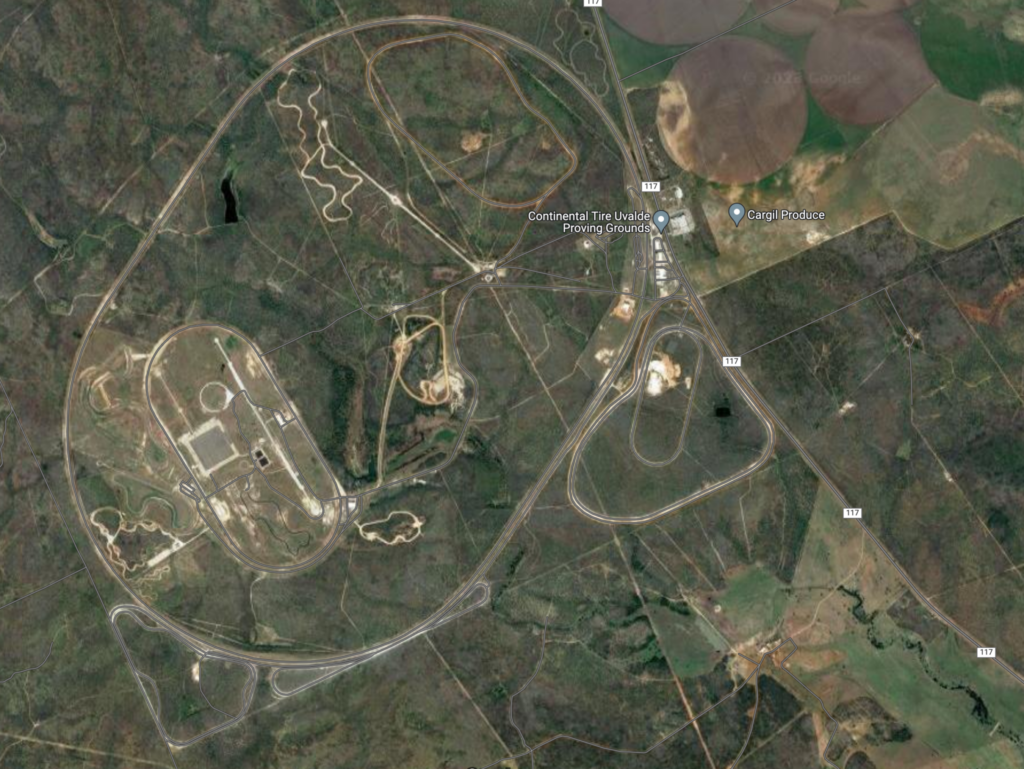
Uvalde Proving Grounds
The Uvalde Proving Grounds has a rich history, starting with its establishment in 1959 by General Tire. Initially, the facility featured an 8.7-mile (14 km) oval circuit designed specifically for evaluating passenger car tires. This track provided a controlled environment for testing cars at speeds that would be impractical on public roads, ensuring highly reproducible and comparable results.
As consumer expectations and tire technologies evolved in the 1980s, additional tracks were constructed at the proving grounds. Tire manufacturers recognized the growing interest in safety characteristics, alongside factors like mileage, performance, and damage resistance. To meet these changing needs, the facility expanded to include a variety of tracks and test surfaces, replicating everything from interstate highways to downtown streets.
In 1987, Continental acquired General Tire, and as part of the acquisition, the Uvalde Proving Grounds became Continental’s asset. With its European roots, Continental shifted the focus from rough road surfaces to handling and safety. The company prioritized reducing stopping distances and preventing aquaplaning, among other safety-related aspects. This shift led to the development of additional testing facilities such as aquaplaning pools, dry handling courses, and wet grip surfaces.
In 2018, Continental engineers introduced a significant innovation to enhance tire endurance testing. They developed a driverless test vehicle that could operate autonomously on the track until it depleted its fuel supply. This automation allowed for precise control over the test conditions, resulting in improved test results, optimized track utilization, reduced wear and tear, and enhanced safety. The introduction of driverless testing eliminated the need for human drivers to spend extensive hours maneuvering trucks over the monotonous track.
Today, the Uvalde Proving Grounds has evolved into a comprehensive testing facility. It encompasses approximately 26 paved and off-road courses and houses a diverse range of test vehicles, including heavy equipment, tractors, passenger cars, light trucks, commercial vehicles, motorcycles, and trailers. The facility also features over 6,000 square feet of shop and private office space, along with secured bays that are available for non-tire automotive-related testing groups.
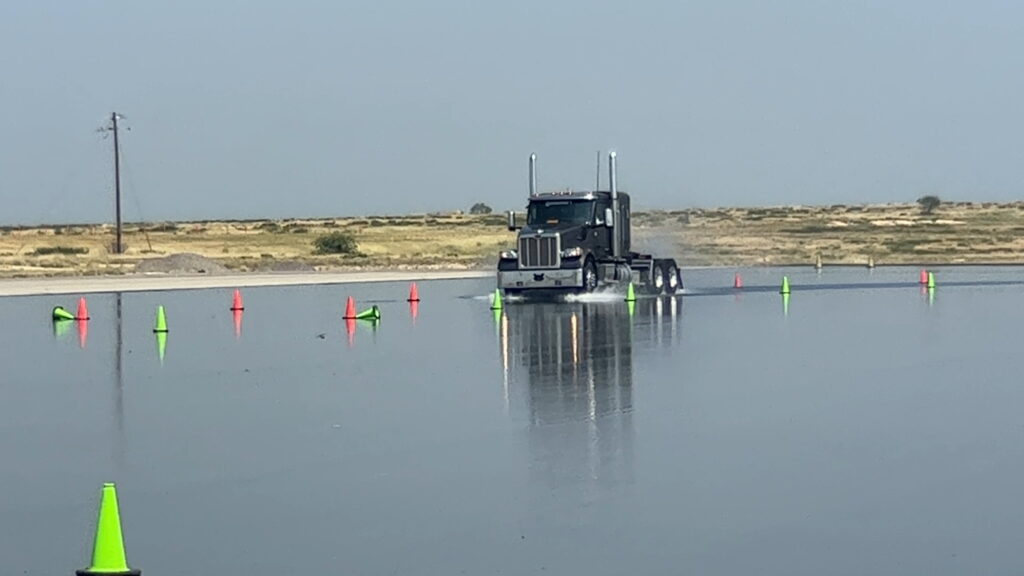
Wet Traction Testing
During the visit to the Uvalde Proving Grounds, Continental couldn’t showcase all the test sites to the journalists, but they did have the opportunity to explore the Wet Handling Track. This track is a massive 800×800-foot, 15-acre asphalt pad, which happens to be the largest of its kind in North America. Although it appears flat, it actually has a 1% grade across its entire surface. This grade allows water from a perforated pipe at the top of the pad to flow in controlled depths ranging from 0.05 to 0.11 inches. The runoff water is collected and redirected to underground storage tanks for future use. To minimize water usage, the facility draws water from an underground well and extensively recycles it for other wet testing areas.
The Wet Handling Track is specifically designed for testing wet traction and maneuverability at high speeds. Vehicles, including cars and trucks, can reach highway speeds before executing various maneuvers, such as accelerating or braking in a turn, navigating long sweeping curves, performing serpentine maneuvers, or even simulating jackknife scenarios.
During the visit, the journalists had the opportunity to drive a bobtail Peterbilt Model 567 sleeper tractor through a long sweeping curve while conducting a full ABS stop. Equipped with Conti Ecoplus HS3+ 295/75R22.5 steer tires and ContiTread HDL 3 LTL-R retread drive tires, the truck maintained excellent traction throughout the curve, even at speeds of 40 to 50 mph (60-80 km/h). This performance was somewhat surprising, considering the bobtail tractor’s light weight, which provides less traction compared to fully loaded trucks. During the full-application ABS stop, the truck maintained a straight line without any deviation. This demonstration showcased the impressive traction capabilities of the showcased tires.
Another testing area at the facility is a straight wet track used for evaluating wet stopping distances. The track is covered with a thin layer of water, allowing the truck to accelerate to 50 mph (80 km/h) and then perform a full ABS stop, which is remotely triggered for measurement purposes. In comparisons conducted by Continental, the previously mentioned retreaded drive tires achieved a shorter stopping distance compared to a competitor’s budget virgin tire. It is worth noting that the competitor’s tire is often chosen by fleets instead of retreaded tires. The retreaded tires managed to stop in 57.175 meters (187.6 feet), while the competitor’s new tire required 57.625 meters (189.05 feet), about two feet further. Although the difference may seem minor, it demonstrates that the specific tread pattern and compound of the retreaded tires are on par with, or even slightly superior to, that particular new tire.
These hands-on experiences on the Wet Handling Track and the wet stopping distance track provided the journalists with tangible evidence of the performance and capabilities of Continental tires, showcasing their traction, stability, and shorter stopping distances compared to competitor tires.
“The biggest obstacle our sales team has to overcome is getting fleets to have confidence in retreaded tires,” said Continental’s product marketing manager, Bridney Jordan, explaining the significance of the test. “Fleets will tell us they don’t believe in retreading, using refurbished tires, etc. That couldn’t be further from the truth. We proved right here that the Conti retread stopped in a shorter distance than that brand new tire.”
When doing actual wet traction testing, they run each test seven times, and drop the shortest and longest run and average the five remaining runs.
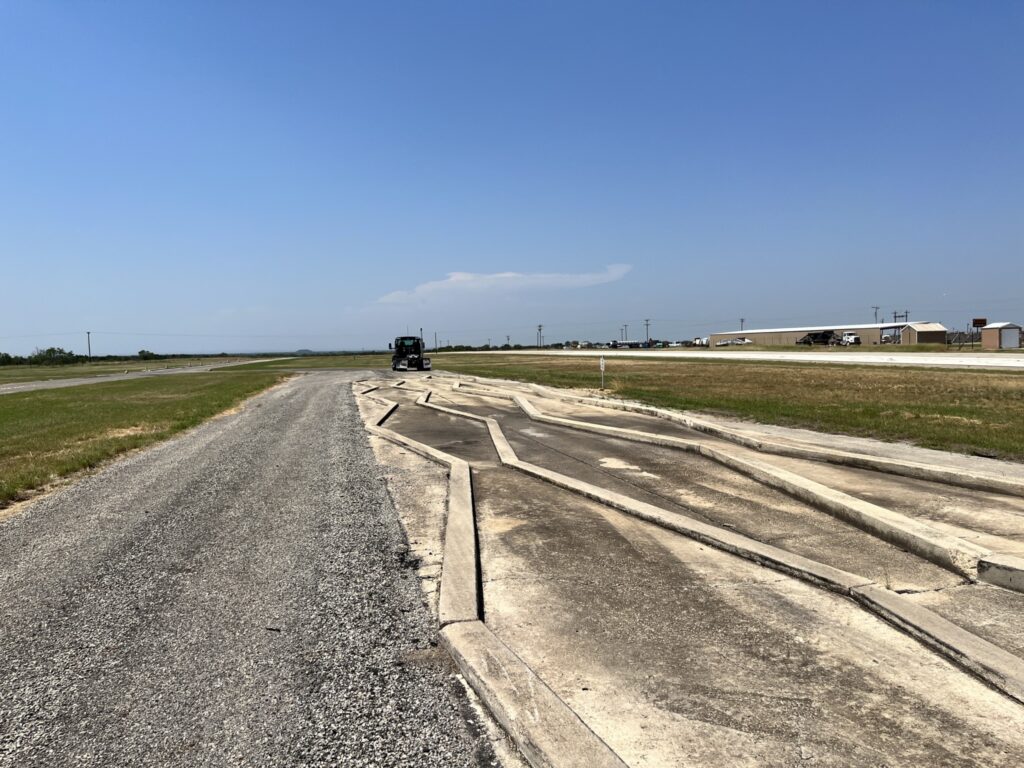
Dry handling test
Although the Dry Handling test at the Uvalde Proving Grounds primarily focuses on passenger cars rather than heavy trucks, it provides valuable insights into the impact of tread compounds, casing design, and tread design on traction and handling.
The track, constructed in 2015, is a 1.07-mile road course with an asphalt surface. It features a 1,200-foot straightaway, as well as curves, turns, and bends ranging from 50 to 500 feet in radius. The purpose of this track is to assess the dry handling performance of tires, including the evaluation of different designs and constructions. Additionally, the course allows for vehicle construction and suspension evaluations.
During the visit, the journalists had the opportunity to drive two laps of the course in two different cars. The first car was a four-cylinder turbocharged Ford Mustang equipped with General Tire G-Max RS tires. The second car was a V-6 Dodge Challenger fitted with Conti ExtremeContact Sport 02 tires.
While the actual testing and evaluations involve extensive instrumentation, the experience for the reporters was somewhat subjective. However, based on their observations, the reporter test drivers concluded that the Dodge Challenger equipped with Conti’s ExtremeContact Sport tires provided notable benefits. They believed that the tires would enable them to achieve an additional 10 mph in speed, and they felt confident in the road handling capabilities even at speeds approaching 70 mph.
Although the subjective nature of the evaluation leaves room for individual interpretation, the journalists’ experience suggested that Continental’s ExtremeContact Sport tires demonstrated enhanced performance in terms of traction and handling on the dry road course, providing a greater sense of confidence and control during high-speed maneuvers.
Curbing test
The Uvalde Proving Grounds also included a curbing test specifically designed for heavy trucks, which aimed to evaluate the resistance of tire treads and sidewalls to tearing, chipping, and scrub damage when driving over and off curbs. During the demonstration witnessed by the journalists, a bobtail tractor was used, which means the tires were not subjected to significant stress. It should be noted that under normal testing conditions, the trucks would be fully loaded.
As the demonstration took place, it was evident from the strips of rubber scattered alongside the curb that numerous tires had undergone rigorous testing, sacrificing themselves in the pursuit of more durable treads and sidewalls. This test helped tire manufacturers assess the ability of their products to withstand the challenges of curbing, which is an aspect of real-world usage that heavy truck tires often encounter.
By subjecting the tires to curbing tests, manufacturers could determine the resilience and durability of their tire designs, ensuring that they could withstand the rigors of commercial trucking operations. The presence of worn-out rubber strips showcased the dedication to developing more robust tires capable of withstanding curbing impacts and minimizing damage to treads and sidewalls.
Specialty tests
At the Uvalde Proving Grounds, there were nine distinct courses specifically designed to assess tires’ resistance to damage caused by rough and rocky surfaces. These courses incorporated various types of rocks, stones, and gravel, which were laid over both hard and soft surfaces. Trucks would navigate these courses for a predetermined number of laps, allowing testers to evaluate the cutting and chipping of the tire treads caused by the gravel overlays.
One of the courses featured a circular bed filled with pea gravel. Trucks would drive through the gravel and then transition onto a hard paved surface, testing the tires’ ability to expel stones lodged between the treads. Additionally, this course helped determine the extent to which any stones that were not successfully ejected penetrated into the tire casing.
Some of the off-road courses at the proving grounds were particularly challenging. They consisted of rocky terrain, with rocks ranging in size from golf balls to softballs, as well as sections with soft sand and tracks embedded with telephone poles. The courses also included steep inclines with gradients reaching up to 33%. Surfaces varied from smooth concrete to dirt covered in gravel. These obstacles allowed engineers to evaluate not only the traction of the tires but also their susceptibility to tread damage.
The purpose of these rigorous off-road courses was to thoroughly assess the performance and durability of the tires under extreme conditions. By subjecting the tires to such challenging terrains, engineers could analyze their traction capabilities and evaluate their resistance to damage caused by rocks, stones, and other rough surfaces. These tests were crucial in developing tires that could withstand the demanding environments encountered by trucks in off-road or rugged applications.
Digital tire monitoring
Continental also presented its digital tire monitoring solution called ContiConnect during the event. This innovative system utilizes proprietary sensors embedded within the tires to monitor various metrics such as inflation pressure, casing temperature, and mileage. The collected data is then transmitted to the ContiConnect web portal for analysis and monitoring.
For over-the-road fleets, there is the option of ContiConnect Live. This solution enables real-time transmission of tire data from the truck to the web portal through the fleet’s onboard telematics unit. This not only provides instant access to tire information but also offers GPS asset tracking, contributing to improved fuel efficiency, extended tire lifespan, and reduced labor costs associated with manual tire inspections. Continental further highlights that this system can also aid in the detection of missing or stolen tires.
Alternatively, local and regional fleets that frequently return to their base of operations may prefer the in-yard option, known as ContiConnect Yard. In this setup, vehicles pass by a reader station located within the yard, where tire data is collected and relayed to the ContiConnect platform. Instant notifications are generated, enabling prompt addressing of any tire-related issues while the truck is still in the yard. Continental emphasizes that this solution allows for tire inspections and fleet checks to be performed without physically touching the tires.
Continental is actively developing a smartphone-based tire scanning app, which will utilize the device’s camera to create a 3D image of the tire. This app, based on facial recognition technology, will be capable of measuring tread depth accurately. The introduction of this app aims to provide a convenient and accessible method for tire inspection, further enhancing the overall tire management and maintenance process.
“All you have to do is walk up and take a photo of the tire and [the app] will connect with the tire’s internal sensors” he said.
The data collected from the sensors, combined with the 3D image generated by the app, is uploaded to the ContiConnect platform. This data becomes immediately accessible and readable by anyone who has subscribed to the service. It allows users to monitor and analyze the tire information effectively, aiding in making informed decisions regarding tire maintenance and management.
Regarding the availability of the smartphone-based tire scanning app, Trey Thompson did not provide specific details during the event, so the timeline for its release remains undisclosed.
While price remains an important factor when purchasing tires, it is essential to consider the tire’s overall quality and features before mounting it on a truck. Opting for a cheaper tire may initially seem like a good deal, but it’s crucial to take into account factors such as its expected lifespan and resistance to damage. If a lower-priced tire has significantly shorter longevity or is more prone to damage compared to a top-tier tire, the initial cost savings may not outweigh the potential drawbacks and expenses in the long run. Considering the comprehensive attributes of a tire can lead to a more informed decision, ensuring better performance, durability, and overall value for the investment.
